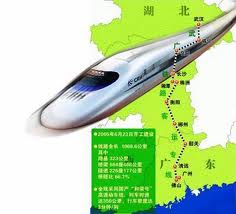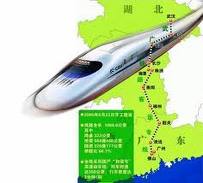





I

magine, one day,getting out of bed in Beijing and being at your office in Shanghai in only a couple of hours,and then,after a full day of work,going back home to Beijing and having dinner there.
Sounds unusual,doesn't it? But it's not that unrealistic,with the development of China’s high-speed railway system.And that’s not all.China has an even greater high-speed railway plan — to connect the country with Southeast Asia,and eventually Eastern Europe.
China is negotiating to extend its own high-speed railway network to up to 17 countries in 10 to 15 years,eventually reaching London and Singapore.
China has proposed three such projects.The first would possibly connect Kunming with Singapore via Vietnam and Malaysia.Another could start in Urumqi and go through Kazakhstan and Uzbekistan,and possibly to Germany.The third would start in the northeast and go north through Russia and then into Western Europe.
If China’s plan for the high-speed railway goes forward,people could zip over from London to Beijing in under two days.
The new system would still follow China’s high-speed railway standard.And the trains would be able to go 346 kilometers an hour,almost as fast as some airplanes.
China’s bullet train(高速客车),the one connecting Wuhan to Guangzhou,already has the World’s fastest average speed.It covers 1,069 kilometers in about three hours.
Of course,there are some technical challenges to overcome.There are so many issues that need to be settled,such as safety,rail gauge(轨距),maintenance of railway tracks.So,it’s important to pay attention to every detail.
But the key issue is really money.China is already spending hundreds of billions of yuan on domestic railway expansion.
China prefers that the other countries pay in natural resources rather than with capital investment.Resources from those countries could stream into China to sustain development.
It’ll be a win-win project.For other countries,the railway network will definitely create more opportunities for business,tourism and so on,not to mention the better communication among those countries.
For China,such a project would not only connect it with the rest of Asia and bring some much-needed resources,but would also help develop China’s far west.We foresee that in the coming decades,millions of people will migrate to the western regions,where the land is empty and resources unused.With high-speed trains,people will set up factories and business centers in the west once and for all.And they’ll trade with Central Asian and Eastern European countries.
小题1:China’s new high-speed railway plan will be a win-win project because ________.
| A.China will get much-needed resources and develop its western regions |
| B.China and the countries involved will benefit from the project in various ways |
| C.China will develop its railway system and communication with other countries |
| D.the foreign countries involved will develop their railway transportation, business and tourism |
小题2:According to the passage,the greatest challenge to the new high-speed railway plan is ________.
| A.technical issues | B.safety of the system |
| C.financial problems | D.maintenance of railway tracks |
小题3:Which of the following words best describes the author’s attitude towards China’s high-speed railway plan?
| A.Critical. | B.Reserved. | C.Doubtful. | D.Positive. |
小题4:Which of the following might be the best title for the passage?
| A.New Railway Standards. | B.Big Railway Dreams. |
| C.High-speed
本试题 “Imagine, one day,getting out of bed in Beijing and being at your office in Shanghai in only a couple of hours,and then,after a full day of work...” 主要考查您对 政治经济类阅读 历史文化类阅读 等考点的理解。关于这些考点您可以点击下面的选项卡查看详细档案。
政治经济类文章的概念:
要做好这类阅读,平时就要注意了解国内外发生的政治经济大事,掌握一定背景知识,对这类文章的叙述特点及内容安排有一定了解,还要扩展这方面的词汇。阅读这类文章,要抓住文章的核心,即文章整体和各段主要在说什么,也要注意段落之间的逻辑关系。 如何备考政治经济类阅读理解题:
【题型说明】政治经济类阅读文章是高考常选材料之一。该类文章时代气息浓郁,语言鲜活,但熟字新义词、超纲词及专业词语多,长句、难句多。政治类文章大多数是同学们感性趣的内容,读起来倒有似曾相识的感觉,经济类文章读起来就像是雾里看花,文章看完,一头雾水。再加之这类文章的命题侧重于词义猜测、推理判断和文章主旨,同学们对这类题材是望而生畏。
【备考策略】建立心理优势。针对不同体裁的文章,我们要采取相应的阅读方法和技巧。政治类文章多采用记叙文形式,我们可采取“顺读法”,以便抓关键语句,领会文章主旨;而经济类文章则多采用说明文形式,我们则可以采取“逆读法”,先读试题,再从文章中查找有用信息。若遇到的确难读的材料。千万不用着急,因为你觉得难,其他人也一定是同感。在高考前,我们就要有这种心理准备,高考试卷肯定有一、两篇难以阅读的材料。不过,我们平时可以有意识地从报刊杂志上找一些较难的阅读材料来阅读,以培养自己迎难而上的心理素质。
【答题方法】
1、寻找主干:
根据英语中五种基本句型结构,把句子中的主语、谓语、宾语、表语等主要成分找出来,其他成分如定语、状语、补语等则易于理解。找到了句子主干,句子的意思至少明白了一半。
2、剔除从句:
在一个长句中可能会出现若干个从句,在理解时,如果把各个从句剔除出来单独理解,然后把大意拼凑起来,整个长句的意思就会明白六、七分。
3、辨别分句:
一个长句如果是由几个并列、转折、递进、对比关系的分句组成,句中往往有表示这些分句关系的连接词,只要能弄清楚分句和分句之间的逻辑关系,再把各层分句的意思加以连贯,整个长句的句意基本上能跃然脑中。
4、寻找关键词:
如果一个句子看完,一点句意的感觉也没有,下下策就是抓住句中的关键词,通过关键词大体弄懂这个长句的意思。 什么是历史文化类阅读:
本类题型常用的方式是夹叙夹议。叙述的目的是为了议,所以要把握其议才是主要方面。阅读这类文章,先弄清其引入的话题,再弄清里面人物对其不同的看法,然后理解作者本身对话题的观点看法或思考。
历史文化类阅读技巧:
【题型说明】历史文化类阅读理解文章属高考常选材料之一。这类文章常涉及历史、文化、法制、宗教等方面的文学艺术、发明创造、文化遗产保护、宗教与文化、风俗与习惯、道德与法制、中外文学名著节选、等等。这类材料的命题点往往落在主旨大意题、事实细节题上。
【答题方法】在做这类阅读理解题时,我们应注意以下几个方面:
1、采用先题后文:先读题目,再带着问题读文章。这类阅读理解文章相对来说事实细节题稍多一点,如果带着问题读文章,有利于我们抓细节。
2、先做细节题。因为做完了局部性的事实细节题后,自然会加深我们对文章的理解,这样更有利于做主旨大意题。
3、重点敲定主旨题。主旨大意题提问的形式主要有两大类:一类是Main idea型;一类是Topic或Title型。
在解答这类试题时应注意以下几点:
a.读首句抓大意。
文化教育类阅读理解文章多采用说明文、议论文体裁,而这类文章大都采用文章段落的中心,即主题句在文章开头。因此,要寻找这类文章的主旨大意就需要研究文章的首句。
b.读尾句抓大意。
有时这类文章的主题句安排在文章的结尾,作为对全篇的总结。
c.读首段抓大意。
有些文章或段落的开头和结尾部分都有主题句。这种结构是为了突出主题思想而使用两次点题的写作方法。这两个主题句在句子结构和用词上有所不同,而且在内容上前句和后句也不重复。
d.从段落中抓大意。
有些文章或段落的主题句在文章中,这种文章或段落往往以一句话或几句话引出要表达的主题,在主题句出现后,再举例子陈述细节或继续论证。
e.归纳要点抓大意。
有些文章或段落无明显的主题句,只是暗示性地体现主题。这就要求同学们在阅读过程中根据文中所叙述的事实或线索来概括总结主旨大意。
与“Imagine, one day,getting out of bed in Beijing and being...”考查相似的试题有:
- If you will be cycling, you will need to know what these traffic signs and signals mean.A sign like this one means th...
- To me,life without music would not be exciting.I realize that this is not true for everybody.Many people get along q...
- 阅读理解。Bowing is a very important custom in Japan. Unlike people in many other countries, they greet each otherby ...
- He came into the room to shut the windows while we were still in bed and I saw he looked ill. He was shivering, his f...
- Work is a very important part of life in the United States. When the early Protestant immigrants(新教徒移民) came to ...
- Puerto Rico may be part of the USA but its music and dance is a mixture of both Spanish and African rhythms. The coun...
- 阅读理解From the beginning of human history, wild animals provided food, clothing and sometimes medicinefor man. We m...
- A blog can be a very effective way of spreading the words about yourself, and your other writing. It canunshroudyour ...
- 阅读理解。She is widely seen as proof that good looks can lastforever. But,at nearly 500 years of age,time is catchin...
- 阅读理解。How would you like to come home after a long day, open the door, and walk into an elephant? That's whatyou ...
|